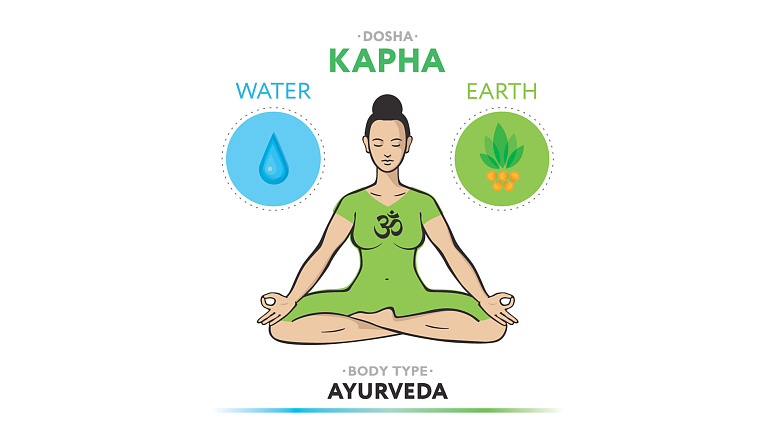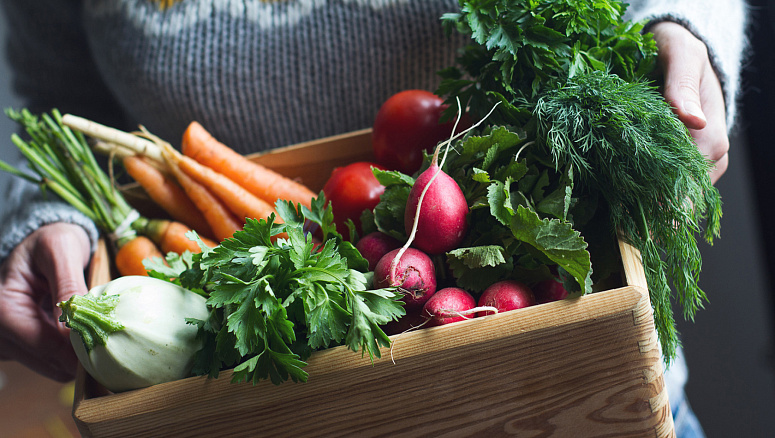What are the qualities of people with Kapha dosha constitution? Kapha is a combination of earth and water elements, so it has a heavy, slow, cold, oily and soft nature. Below we will discuss how these qualities manifest in a physical body, character and diet for Kapha.
Doshas are one of the fundamental concepts in Ayurveda, helping us to better understand ourselves and the world around us. All three doshas: Vata, Pitta and Kapha, are equally important to our physiology. Therefore, none of the doshas is better or worse than the others. Each has a specific set of qualities and functions. When they are out of balance, person's physical health and emotional state deteriorate. Therefore, it is important to study the individual constitution and regulate life according to one's nature.
Manifestations of Kapha dosha
What are the qualities of Kapha dosha? Kapha is a combination of earth and water elements, so it has a heavy, slow, cold, oily and soft nature. How do these qualities manifest in a physical body?
Kapha-dominated people are usually heavy built and predisposed to being overweight. Slowness manifests in gait and speech, as well as sluggish digestion and metabolism. The moist nature of Kapha is conductive to mucus formation and often provokes coughs and rhinitis.
The qualities of earth are manifested in inertness: Kapha people are inert, lazy and idle.
Character of Kapha people
The nature of earth makes Kapha people energy stable not only physically, but also mentally. It seems that nothing can throw them off balance. They are always patient, understanding, able to handle multiple problems at the same time.
Kapha people attract others with their gentle character, tactfulness, forgiveness and loyalty. On the other hand, they are slow, conservative and shy. Sluggishness also applies to their mental abilities: they are often unable to take in information quickly. But once they remember something, it will stay with them forever.
Kapha people are sentimental romantics who get attached easily and find it hard to part. They don't really like travelling, as they feel best at home.
Imbalanced Kapha is manifested in greed, vindictiveness and avarice.
Physical characteristics of Kapha dosha
Kapha people have good health, stamina and vitality. They quickly gain extra weight and struggle to lose it. The skin of Kapha-dominated people energy is dense, soft and shiny. Hair is thick, soft and wavy. The cold nature of Kapha dosha makes people with its dominance not too sensitive to hunger and thirst.
The slow nature of Kapha manifests in slow digestion and metabolism, which leads not only to overweight but also to frequent colds.
Causes of Kapha dosha imbalance
Kapha-type people are usually the healthiest and happiest. However, winter and early spring can throw Kapha dosha off balance. During this period, when cold, damp and heavy weather prevails, Kapha (phlegm) accumulates in the body and can lead to imbalance in the mind and body of Kapha prakriti. Excessive mucus and phlegm make Kapha people susceptible to colds, flu, runny nose, bronchitis, sluggishness and swelling.
At the psychological level, people with Kapha dosha constitution suffer from avarice, unhealthy attachment, envy and lust. These mindsets can lead Kapha people to depression.
How to understand when Kapha dosha is out of balance?
- Weight gain and swelling.
- Apathy, laziness, decrease in mental sharpness and clarity of thoughts.
- Constant cravings for sweet or salty foods.
- Mucus build up in the lungs and sinusitis.
- Prolonged Kapha imbalance leads to blood stasis, varicose veins and thrombosis.
- Cholesterol increase.
- Hypertension.
- Increased sweating, itching and hives.
- Fatigue.
- Nausea, excessive salivation.
- Excessive sentimentality and tearfulness.
Basic principles to restore Kapha dosha balance.
To bring Kapha dosha back into balance, follow a daily routine, practice yoga, walk more, increase physical activity, and eat light and warm foods. It is best to understand the nature of Kapha and maintain the balance paying attention to your current state.
If there is excessive heaviness in the body, stomach or head, get active. Dynamic exercise, light food and walking meditation help the most.
During the cold season, it is important to keep your body warm: dress warmly, drink warming beverages and socialise with friends.
Practicing Pranayama can help with excessive moister. This practice has a drying effect and removes congestion from the bronchi and nasopharynx.
The main factor for the balance of Kapha dosha is activity. It is necessary to move, choose dynamic types of yoga and diversify the daily routine as much as possible.
It is important to watch your diet: avoid heavy, cold and fatty foods. Foods with light and dry qualities are suitable for balancing Kapha.
Kapha dosha diet
- Spicy, bitter and astringent foods.
- Warming spices: chilli pepper, black or cayenne pepper, ginger, cinnamon and cumin.
- All products must be freshly prepared.
- Room temperature or warm drinks.
- Most legumes: mash, tofu or warm soya milk.
- More vegetable.
- Minimum dairy products.
- Eating in a quiet environment.
List of foods that are best to avoid.
- Foods with a sweet, sour and salty taste.
- Foods with cooling qualities.
- Heavy and fatty foods (cheese, nuts, cakes).
- Processed foods (canned, frozen foods, semi-finished products and pastry).
- Cold or carbonated drinks.
- Do not consume fresh fruits and juices within half an hour of taking another meal.
- Foods or drinks containing refined sugar.
- Foods fried in large amounts of oil.
- Alcohol.
Recommended products
- Fruits: apples, berries, cherries, mangoes, peaches, pears and raisins. It is better to avoid dried fruit if possible, except figs and prunes.
- Vegetables: spicy and bitter tastes: beetroot, cabbage, carrots, cauliflower, celery, aubergines, garlic, lettuce, mushrooms, onions, parsley, peas, radishes, spinach, fennel and Brussels sprouts.
- Grains: barley, corn, millet, oats and basmati rice in small quantities.
- Sweeteners: natural honey and raw cane sugar.
- All spices.
- Dairy products low-fat products in small quantities. Preferably soya milk. Avoid fatty cheeses and cottage cheese.
- Oil and butter: some nut butter and corn oil.
In conclusion, Kapha dosha brings peace and a sense of happiness into our lives. Therefore, its balance is the key to stability and harmony, which not only yoga practitioners, but all people on Earth strive to achieve.
Health, physical strength and stamina depend on the balance of Kapha dosha. As we can see, keeping Kapha in balance is not difficult at all. Especially if we have the invaluable knowledge of Ayurveda at our disposal!


